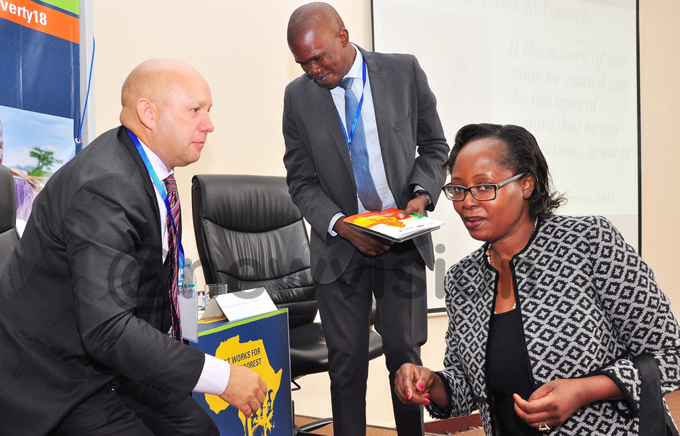Eradicate child poverty to achieve middle income status, experts say
Experts have called on the Government to invest more in social protection of children to end the multidimensional poverty.
A Manchester University lecturer at the Global Development Institute in the school of Environment, Education and Development, Dr. David Lawson interacts with the Economic Policy Research Centre (EPRC), Principal Research fellow; Ibrahim Kasirye during the International Conference on child poverty in Africa in Kampala. PHOTOS: Juliet Kasirye
Uganda's vision of becoming a middle income country by 2040 remains highly dependent on government safeguarding children's rights and intensifying its efforts towards the reduction of child poverty.
Dr. Doreen Mulenga, the UNCIEF representative says while there has been substantial progress in reducing global poverty in recent years, millions of vulnerable children remain stuck in extreme poverty
"Evidence from around the world from high income, middle income and low income countries alike shows that millions of children continue to experience deep poverty, deprivation and exclusion," she says.
In Uganda, 3.7 million children under five years (55%) are living in multi-dimensional poverty. This is the same for 38% of all 6-17 year olds across the country equally deprived of many basic services and fundamental rights, according to Ibrahim Kasirye, the Principal Research Fellow at the Economic Policy Research Centre (EPRC),
These include health care nutrition, education, water, sanitation, shelter and information that they need to develop their full potential.
According to statistics from Economic EPRC, the rate of deprivation is high in West Nile and Karamoja regions where 68 percent are trapped in poverty followed by the central region at 60 percent.
Western Uganda which constitutes districts such as Bundibudyo, Kyenjojo and Kabalore posted 57 percent similar to that of eastern Uganda's 57 percent.
Experts have called on the Government to invest more in social protection of children to end the multidimensional poverty.
They noted that Uganda contributes less than half of what her neighbours Tanzania and Ethiopia contribute do towards social protection of children.

(L-R) Manchester University Dr. David Lawson interacts with the UNICEF representative in Uganda, Dr. Doreen Mulenga as the Economic Policy Research Centre (EPRC), Principal Research fellow; Ibrahim Kasirye (centre) looks on.
David Gordon, the Director Bristol Poverty Institute and Townsend Centre for International Poverty Research University of Bristol, UK, revealed said Uganda contributes 0% from public money on social protection of children.
"Uganda spends 4.4% of her national income while Tanzania and Ethiopia spend about 10%. Much of Uganda's support is from child organizations. It is not that Uganda could not afford, may be they decided other things are more important," he said.
He was making a presentation at the International Conference on Child Poverty in Africa under theme; "What works for poorest children" at Protea Hotel in Kampala yesterday (Monday).
Uganda's potential
Gordon noted that Uganda can achieve its target of eradicating poverty by 2030 if there is a political will, because it has abundant resources.
"Uganda has made commitment national and international to reduce child poverty by half by 2030. There has been progress but, this the progress stalled in the last six years and there it needs double her efforts if it's to meet its own targets," he noted.
He noted that extreme child poverty (people living on very low incomes) constitute over 21%. "So parts of country cannot adequately earn money to look after their children to pay for them fees, provide medical care and feed them among other basics.
The government needs to be refocusing on efforts to help the poor situation in Uganda particularly in parts which have suffered multiple problems if insecurity," he said.
What more can be done?
In Uganda 57% of the population is under the age of 18 while 78% is under 35. Considering the high fertility rate of over five children born to every woman of reproductive age in Uganda, the child population is projected to double over the next 25 years.
This is from about 20 million children today to around 40 million in the 2040s.
Mulenga says the challenge is that the large majority of countries across the continent don't have definitions or measures of multi-dimensial adult or child poverty or anti-poverty policies which specifically target children and young people.
Meaning the approaches to poverty alleviation in most African countries including Uganda need to be urgently reconsidered.
Mulenga says in this time of unprecedented population growth occurring coupled with high levels of child poverty will have huge implications for Uganda and the continent that include among other a lack of skilled labour force, high unemployment rates and an increase in crime plus violence.
He says only the right policies and sufficient investment to lift children out of poverty will see Africa realise socio-economic development and Uganda a middle income country status by 2040.
The Conference, first of its kind, attracted over 50 global experts from various parts of the world. It was organised by Economic Policy Research Centre (EPRC) with support from UNCIEF and University of Manchester.